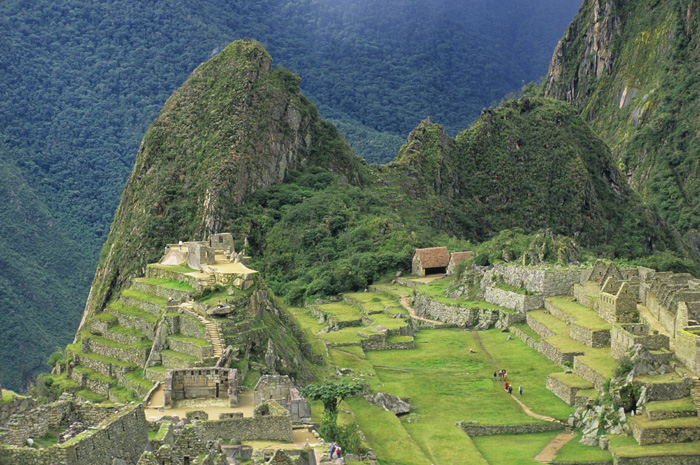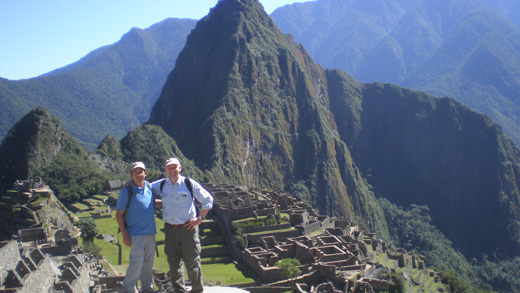Machu Picchu Magic

Editor’s note: The story below, reprinted from The Way of Wanderlust: The Best Travel Writing of Don George, recounts a life-changing moment on a GeoEx journey through the Sacred Valley of Peru to storied Machu Picchu.
For decades, Machu Picchu had been at the top of my Places to Go list, but somehow, in twenty years as a travel writer visiting more than seventy countries, I still hadn’t gotten there. In the spring of 2010, I was beginning to despair that I ever would. Then, through a combination of serendipities, I was invited to take an eight-day trip to the Sacred Valley, culminating in a visit to Machu Picchu.
I spent my first days in the Sacred Valley exploring cultured, cosmopolitan Cusco and the ancient sites of Moray, Pisaq, and Ollantaytambo. Then, on my third day, I awoke at 5:40 a.m. to bird trills, wood smoke-scented air, and barely containable excitement. Today was a day I’d been waiting for most of my traveling life: We were going to Machu Picchu!
My guide, Manuel, and I hit the highway at 6:00 a.m., passing sheep, pigs, and cows being herded into pens and villagers in brightly woven capes and great hats walking along the side of the road. After 25 minutes we arrived in Ollantaytambo, where porters in bright red ponchos waited for Inca trail trekkers; too pressed for time to make the four-day trek, we were taking the quick route: a storybook blue train to Aguas Calientes, the town nearest Machu Picchu, where a bus would wend to the base of the site.
On the 20-minute train ride, Manuel pointed out where bridges had been washed out or railroad tracks twisted and tossed into the river by the floods that had raged a half year before: stark reminders of nature’s raw power. This train, he said, had restarted operations only three months earlier. I thought of the Inca temples we’d seen and of Manuel’s words at the beginning of our trip: “The Spaniards called them idolators and maybe they were—but I think they did very well; they had a big respect for nature.”
Then we reached booming, ragtag, pizzeria-and-hostel Aguas Calientes, where we walked through a market maze and boarded the bus for the 20-minute back-and-forth bounce up the dusty road to the ruins.
***
Here’s the thing about Machu Picchu: No matter how many photographs you’ve seen, stories you’ve read, or posters you’ve absorbed, nothing can prepare you for the surreal whoosh of actually being there. From the spot where the bus drops you, you walk up some narrow stairs and some winding paths, the sun beating on you, the sweat starting to trickle down your back, and then you reach a level area and take a few more steps and—whoosh!—suddenly there it is, spreading out before you, the gray granite walls and poky roof remains and green open lawns and jungly green rock-thrusts just beyond. Suddenly it hits you: Machu Picchu—I’ve arrived!

For a while you just stand and stare, absorbing it, letting it seep into you. Then eventually you become aware of the other travelers, some as stunned as you, and you decide it’s time to head into the ruins. And then time suspends, and you spend two, three, four—you don’t know how many—hours wandering, letting your hands trail along the rock, smelling the grass and the granite baking in the high-altitude sun. You visit the agricultural sector and the industrial zone, the Temple of the Three Windows and the Temple of the Condor, the Sacred Square and the priests’ chamber, the House of the Virgins of the Sun, the Watchman’s Hut, the cemetery, the Temple of the Sun and the sundial. But what you are really doing is walking through time.
You’re imagining what it was like 500 years ago when a thousand people lived here—their woven clothes, the potatoes and maize they grew, the grain they stored, the granite they dragged laboriously from the quarry and the gold and silver and chisels, the wood and water, they used to break down and shape the stone. You imagine the runners arriving from Cusco, the robed priests, the weavers and warriors, the singers and teachers and pottery-makers.
And then you’re imagining what it was like 99 years ago, when a twelve-year-old boy brought a discouraged Hiram Bingham to this rocky revelation. What must it have felt like to gaze on this tumble-jumble of intricately wrought walls and plazas, trees and vines? You imagine the crescendo of emotion and astonishment, the arc of enlightenment, as Bingham gradually realized what he’d found, what he called the Lost City of the Incas.
And then you think about what this discovery set off, a succession of events every bit as tangled and dramatic as those ruins: A foreigner recognizes the significance of this remote site, clears and plunders it, and in so doing creates a global icon that is responsible for sustaining as much as 80 percent of the local economy today, and that has literally put Peru on the international tourist map. This eventually encourages the Peruvian government to reallocate significant resources to study and preserve other ancient sites and artifacts in the area. The ever-swelling procession of Machu Picchu pilgrims, even as it underpins and integrates the local economy, threatens to undermine and disintegrate the site itself.
You recall what Manuel said on the train, how the torrential rain and floods of earlier this year dramatically demonstrated just how economically fragile the economy of the Sacred Valley is, how much it depends on this one site: From February to April, when floods took out those tracks from Ollantaytambo to Aguas Calientes, 78 percent of visitors to the region canceled their trips.
So visiting Machu Picchu is, like the site itself, multi-layered: There’s the historical backstory, the cultural backstory, and the economic backstory. And then there’s the pure human experience of being present at Machu Picchu. All of this roiled inside me as we roamed the ruins. I felt a pulsing presence there, but something wasn’t quite connecting, somehow it wasn’t getting through to me. Before the thought formed in my head, I knew it in my heart: I had to come back at dawn.
***
The next morning I awoke as the sun was just starting to tint the sky, and made my way in the crisp Andean air through the warren of just-opening stalls selling booklets, blankets, and bug repellent, to the Aguas Calientes bus stop. With about two dozen Peruvian guides and Western and Japanese tourists, I piled into the bus for the weaving 1,500-foot ascent to the ruins. As the bus jounced and switchbacked through the lightening dawn, a feeling I’d had for years, a yearning, an expectation—that something was waiting for me at Machu Picchu, that something would be revealed to me there—weighed undeniably in my stomach and my mind.
As the sky brightened, I worried that I was too late. But I had forgotten that Machu Picchu, despite its high altitude, is still a bowl surrounded by towering peaks. I raced up to the site and saw with relief that while the peaks to the west were tipped with bright sunlight, the ruins were still in shade. I made my way directly to the sundial, known as Intihuatana or “hitching post of the sun,” which sits atop a pyramid-like construct of terrace and wall in the site’s northwest quadrant.
I positioned myself at the sundial and waited, absorbing the stony stillness and the fresh scent of grass, the texture of tree. I watched the sun’s rays light the peaks behind and around me, slowly getting higher and higher, closer and closer.
Minutes passed. The molecules in the air ever so slightly brightened. Then, in a suspended moment, light flared over the top of the mountain directly in front and touched the sundial.
I was looking through the lens of my camcorder when it happened, and at the moment the sun appeared, rays shot out in six searing streaks at 45-degree angles. I felt like one streak was searing through me as well. I felt transfixed, transformed. For a suspended moment I felt drawn into the sun, enwrapped by the sun, plucked into some profound energy-stream of sun worship that coursed through the ground where I stood. This flowing energy seemed to stitch through me and through the world around me—the sundial, the rock plazas, doorways, and walls, the temples and the terraces. For a moment I felt a thoughtless understanding, a pure, empty-headed universe-connection, a solar spear-tip that pierced my heart and soul.
Then it was gone. A group of gossiping students clambered over the rocks, guides replayed their learned lectures, camera-wielding couples postured and posed. But somehow, everything had been transformed.
In retrospect, all I can say is that some deep energy radiates from that place. It’s a combination of the altitude, the pristine quality of the ruins themselves, the purity of the air and the sky and the sun—and something else too, a kind of spiritual energy that courses like water-springs through the site. I had felt it on the Sacred Plaza and by the Temple of the Sun, but I felt it especially at Intihuatana at dawn: the hitching post of the sun.
At mid-morning, Manuel joined me and we took a walk along the Inca Trail. Most trekkers take the trail from Ollantaytambo or from an intermediate stop called Kilometer 104 along the rail line to Aguas Calientes, but Manuel and I met at the Watchman’s Hut and walked up the trail in the opposite direction, away from the ruins and toward the Sun Gate, or Intipunku, where trekkers first see Machu Picchu. We shared the paved path with orchids and llamas and workers who were trying to repair one section of the trail that had been weakened during the rains. Looking into the jungle to the right of the trail we could see more Inca walls in the thick shade. Manuel said there were probably Inca walls scattered throughout the mountains. The dense slopes seemed alive with them, echoing with the spirit of the people who tilled, ate, and slept, planted, played, and prayed here 500 years before.
We reached Intipunku and then continued along the Inca Trail away from the site. We descended into a world of luxurious blossoms and thick cloud forest shadows. I remarked to Manuel that I was amazed by how well the path was paved, and he told me that at its height, the Inca empire had been laced by a network of 19,000 miles of trails, virtually all paved. I stopped and touched my hand to the rough stone and tried to conjure the imagination and organization, technology and toil, required to complete such a feat. I tried to picture the worker who had placed the very stone on which I stood, whose fingers had touched the very pocks and ridges my fingertips traced. What did he eat? Where did he sleep? What did he dream?
We walked for a half hour to a point where we could see another ruin on a mountain slope: Winay Wayna, a cleared site most trekkers detour to explore. I thought of the deep-shaded walls we’d passed before—who knew what secret cities these vast jungles still held?
The trails wound on and on, I realized, some into the cloud forest fastnesses, some into the secret cities of the soul. Then I thought back to that dawn moment when some inexplicable energy had stitched the sun to all—and on that lonely, well-trod mountain trail, I finally felt whole.
#####
To purchase this book, click here.

